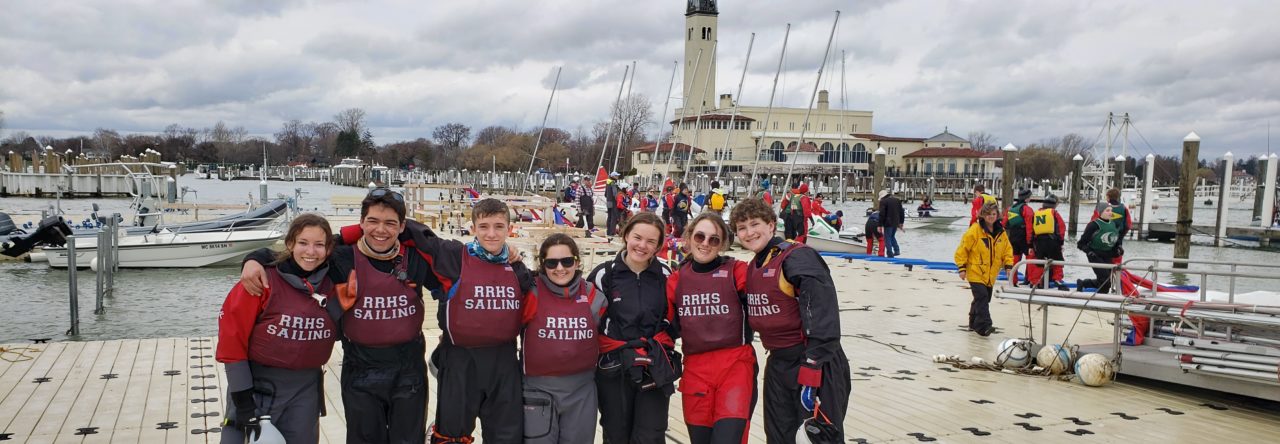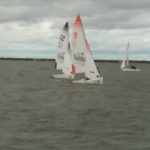The absolute bare minimum amount of equipment is a lifejacket, some sneakers and a helmet. As the weather gets colder, more gear is necessary. The full gear list is linked here.
Foul Weather Gear
While not needed in the first few fall Regattas, foul weather gear is needed during the later Fall season and for all of Spring season.
No one gear list that will be right for every sailor, and there are many different options that will work.
If your family is new to sailing, trying to figure out what to buy can be overwhelming! In your search for gear, the folks at APS (Annapolis Performance Sailing, www.apsltd.com) provide excellent advice, great service and, in general, are a very good source for information and gear. However, there are many other sources.
When choosing dinghy sailing gear, you will rarely regret buying from apparel from Gill. Great quality, and usually a very good value. Manufactures such as Helly Hansen, Musto and Zhik also make great gear, but they tend to be a bit more expensive. Also, gear marketed as sailing gear often seems to be priced higher than similar gear marketed for other watersports. It can help to look for similar alternatives, though it is helpful to read the descriptions and reviews carefully before buying to make sure that the alternate-use gear will perform as needed.
Another option is Sound Boatworks (http://www.shopsoundboatworks.com).
Here is a video on dinghy sailing gear from APS. It might provide some helpful information. There are a wide variety of other informational videos from APS about gear and apparel here.
Obviously, the goal is to keep your sailors safe, warm and comfortable while practicing and racing. Using layers that can be added or removed to maintain are always the key to achieving this goal.
Outer Layers
Having an outer layer that will help keep all of the inside layers dry is very important. In some cases, the outer layer may provide some warmth. Outer layers should be big enough to accommodate one or two base layers underneath, but not so large that they are baggy. Naturally, if your sailor is still growing, then you will have to try to factor that in as well.
Base Layers – Tops
Starting with base layers, most sailors wear a non-cotton, long-sleeve tech shirt as base-layer top. Anything that will wick away perspiration will work. As the weather gets a little colder, a polar fleece layer over top of the tech shirt is a good option to provide warmth.
Whether the temperature calls for a short sleeve tech-shirt, a long sleeve tech-shirt or even a polar fleece underneath, one of the primary pieces of outerwear that your sailor will want is a commonly referred to as a spray top. Though there are other companies that make spray tops, you can’t go wrong with one from Gill, such as these (http://www.apsltd.com/gill-dinghy-pro-top-smock-mens.html) (http://www.apsltd.com/gill-dinghy-pro-top-smock-womens.html). Until we get into much cooler air and water temperatures, this combination of gear should keep the top of your sailor warm, dry and comfortable.
Base Layers – Bottoms
There are a couple of gear options for your sailor’s bottom half. One option is to get a pair of bibs, such as these (http://www.apsltd.com/gill-dinghy-pro-bib-trousers-2018.html) (http://www.apsltd.com/gill-womens-dinghy-pro-bib-trousers.html). This option seems to be a bit more popular with male sailors than with female sailors. They are comfortable and that your sailor can wear a base layer under them for added warmth. However, they can be a bit bulky and they are normally unsealed. So, water does get in when the sailors go in the water.
Another option for leg coverage are neoprene pants or tights that are available for a variety of watersport activities, such as kayaking and paddle boarding. . Sailing specific pants are also available, such as these (http://www.apsltd.com/gill-hydrophobe-trousers.html) or these (http://www.shopsoundboatworks.com/giwehitr.html), for example. The sailing specific pants seem to be more expensive than those labeled for other watersport activities, but sometimes include padding or wear areas that are specific to sailing. The guys seem to wear a pair of short over their tights.
Footwear
While sailing in wool socks and Converse (or other lightweight sports shoes) is a common option, sailing in “hiking boots” like these is preferred. Sailors wear the hiking boots either barefoot or with thin non-cotton socks. (http://www.apsltd.com/gill-trapeze-boots-41817.html)
Boot/Glove Dryers
Given that the gear comes home wet 4 days a week, you may want to invest in a boot dryer. Some have glove dryers as well. They can dry out the boots overnight. (https://www.amazon.com/PEET-Dryer-Original-2-Shoe-Electric/dp/B001J4HQ76)
Gloves
There are a lot of glove options.
- A good, inexpensive option is to use thin, non-cotton liners with regular kitchen rubber gloves over them. The trick is getting the fit right. Different rubber gloves have different length and size fingers. Finding liners that fit your sailor’s hands right and then rubber gloves that fit over the liners in a comfortable way can take a little trial and error.
- A good but more expensive option is these (http://www.apsltd.com/gill-three-season-gloves-17.html).
Wetsuits/Drysuits
Once the air and water temperatures get really low, the sailors will need to wear at least a full wetsuit and at some point when the air/water is very low, a drysuit. A drysuit is a waterproof, full body, zip-up suit with tightly sealing wrist and neck cuffs. Drysuits with ankle cuffs are available, but you will want to buy the version with neoprene booties built in. Your sailor will wear some non-cotton socks under the booties and then Converse or “hiking boots” over the booties. Some drysuits come with a full-body fleece liner that can be worn under the drysuit for added warmth. In other cases, such a liner can be purchased separately. Such a liner is optional, though, and other layers can be worn instead.
As you will notice, drysuits are expensive. It is unclear whether the sailors will need them for the fall season. Obviously, that will be weather dependent. However, drysuits will be required for the spring season. Though other options are available, the Gill drysuit (http://www.apsltd.com/gill-pro-drysuit-breathable-front-zip.html) is a great option. But, don’t buy one now.
We are sometimes able to get a discount on a group Gill order. More to come.







